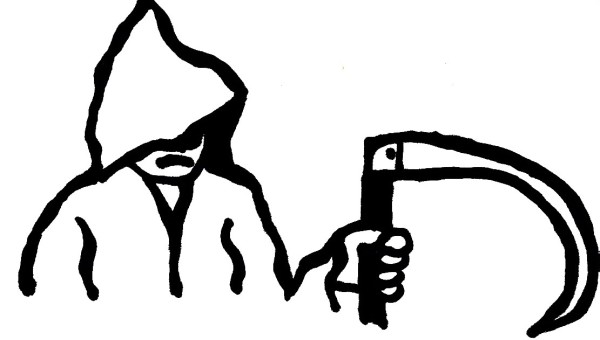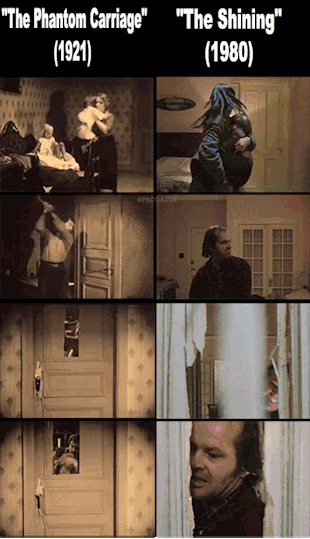
Every month one of us makes the other two watch a movie they’ve never seen before & we discuss it afterwards. This month James made Britnee & Brandon watch The Seventh Seal (1957).
James:
Ingmar Bergman’s classic The Seventh Seal was the Swedish auteur’s first major film and helped establish art-house cinema when it won the Special Jury Prize at the 1957 Cannes Film Festival. Set in Europe during the Black Death, the film follows Antonius Block, played by the great Max Von Sydow, as he tries to outwit the personification of Death in a game of chess. The film is now remembered mostly for its historical significance and that iconic image of Death, parodied in movies like Bill & Ted’s Bogus Journey and Last Action Hero, rather than its substance. That’s a shame because The Seventh Seal is thematically rich and a masterpiece of cinematography. A jester’s performance interrupted by a procession of the plague stricken. An innocent woman burned at the stake. The Dance of Death. The stark black & white images Bergman presents are haunting, evocative, and foreboding, staying with you long after the final credits.
But watching the film again, I can see why The Seventh Seal isn’t as highly regarded as some of Bergman’s later films. As an art-house film, it is an intellectual, philosophical movie that modern audience might find too heavy and bleak. It also tackles one of the deepest and most disturbing questions of existence: Why, in the face of so much evil, does God remain silent? The Silence of God is a theme Bergman would explore in later films like Through a Glass Darkly and Cries & Whispers but in those films he found more nuanced ways to get his message across. In The Seventh Seal, by contrast, Bergman strips away everything in the story that doesn’t embellish the allegory, making it feel almost like a sermon. And as with most sermons, the effect the film has on you depends greatly on if you are on board with its message. The film’s rejection of religious dogmatism in favor of humanism was something that was very powerful for me when I watched it as a teenager. The scene where Antonius confesses his doubts about God and lines like “In our fear we make an idol and call it God” fed the existential angst of my teenage years but now the film seems somewhat heavy-handed.
Brandon, do you feel the film’s lack of subtlety helps or hurts its overall message?
Brandon:
This may be a result of watching the film with fresh eyes, but the heavy-handed nature of the sermonizing worked for me, if not only because it was backed up by the strength of the film’s images. Death appears very early in the film & his iconic chess match with Max von Sydow’s Antonius is initiated almost right away. Also, the way the film is so conspicuously staged (it was mostly filmed on a studio lot) is mirrored in the traveling theatre troop’s performances, which feels like Bergman intentionally pointing out the artificiality of the world he’s created here. The movie’s honest & explicit about the fact that it’s sermonizing about the fruitlessness of life & The Silence of God and the atmosphere of a stage play is well suited for the task. The brutal imagery of the plague that haunts the proceedings also supports the weight of the lofty subjects discussed throughout. The only element that didn’t land for me was Bergman’s added gallows humor. The line of jokes surrounding the blacksmith’s wife’s affair was particularly flat for me, but ultimately it was so inconsequential in comparison to the towering presence of the film’s ideology & imagery that it didn’t affect my viewing too much.
Speaking of artificiality & stark imagery, it makes total sense that Death’s visage from this film has had such a long life in pop culture. Somewhere between a mime & a wizard, it’s a simple look, but an unnerving one all the same. Just like with last month’s The Masque of the Red Death, Death is portrayed in The Seventh Seal as an indifferent inevitability. The difference between the two portrayals is in Death’s sense of humor & amusement here. He allows himself to be tricked into the iconic chess match with Antonius because it amuses him and later poses as a priest to take the knight’s confession in a church for much of the same reason. The Red Death would never have participated in such tomfoolery. Bergman’s intense focus on portrayals of Death in art are prevalent throughout the film: an artist paints The Dance of Death in a church; the traveling actors wear a Death mask in their play; characters frequently sing about Death, God, and Satan in their leisure time. Even the image of Death playing chess that Bergman chose to portray early in The Seventh Seal is lifted from a real-life Medieval painting by Albertus Pictor, which is acknowledged by the knight in the film. When another knight asks the church painter why he paints images of Death, he responds: “To remind people that they’re going to die,” and reasons that people like to be scared & a skull can be more interesting than a naked woman. The church painter seems to be Bergman’s direct mouthpiece in this scene, an artist standing in for the artist at work.
Britnee, how did you react to the portrayal of Death in this film? Does his playfulness & humor detract from his scariness or only add to it?
Britnee:
I’ve avoided watching The Seventh Seal for years because artsy films about death just aren’t my thing, but I’m glad that Movie of the Month exists because I would’ve never given this remarkable film a chance. The film’s statements about the silence of God were so blunt and direct, which really took me by surprise and left me with some haunting thoughts. The scene with Antonius confessing to the priest, who was actually Death in disguise, was probably my favorite scene because he’s just so honest and genuine throughout his entire rant. My appreciation for his authenticity was at an all-time high at that point. Now, as for Death, I really believe that his humor and silliness most definitely contribute to his scariness. The fact that he’s having a good old time messing with Antonius is definitely creepy because it makes him seem almost human. I think the concept of the uncanny can explain how Death’s humor is terrifying. Humor, silliness, and playfulness are very human-like traits, but while these traits are familiar to us, the forces of Death are quite unfamiliar.
I really enjoyed the connection Antonius had with Jof & Mia. When he watches their family come together, there seems to be a change in his character. Jof, Mia, and their son, Mikael, are a sweet little family with nothing but love for each other, and they are so different from all the other characters Antonius encounters in the film. He is intrigued by their simplicity, morality, and the way they represent a sign of light in a world of darkness. He is waiting and searching for an opportunity to do something that would really give his life meaning, and at the end of the film, he is able to distract Death from taking the lives of Jof & Mia. After reading a couple of articles about the film, I noticed that many compare Jof, Mia, and Mikael to Joseph, Mary, and Jesus. Honestly, I don’t believe that they are direct representations of the Holy Family, but I do think they represent how being simple and virtuous can give meaning to life and make it worth living.
James, what do you think Bergman was trying to portray with the Jof and Mia? What do they symbolize?
James:
You hit the nail on the head when you describe Jof, Mia, and Mikael as a sign of light in a world of darkness and I think, through them, Bergman is trying to articulate his vision for the only real way to “cheat” death. For me, each major character (Antonius, the squire, and Jof and Mia) reacts differently to the “Silence of God” to represent a broader way that human beings deal with Death. There is Antonius, who reacts with anger, disillusionment, and hopelessness; the squire, who seems more cynical but at peace with the absurd nature of being alive; and Jof and Mia who, while maybe naive, fully embrace life, family, and art despite the dread and despair that surrounds them. As Jof, Mia, and Mikael are the only characters to survive the film, I think Bergman is trying to say that the only way to conquer the fear of death is to truly embrace life, which makes the film, in my eyes, an ultimately uplifting one.
Brandon, do you agree with this interpretation? What do the different ways that the characters react to death symbolize to you?
Brandon:
I agree that there is an undeniable dichotomy set up between the way Jof & Mia gaily approach mortality as opposed to Antonius’ unhealthy obsession with it. If no characters were to survive the film, the couple’s final days would have been much more pleasant than Antonius’ fretting over how to cheat his inevitable demise. Even their occupations reflect their relationship with mortality. As a knight, Antonius is duty-bound to interacting with death on a regular, militaristic basis. As traveling performers, Jof & Mia entertain the living, bringing amusement into people’s lives instead of protecting their demise or threatening to end them.
Jof & Mia’s playful, jocular approach to living is contrasted not only by Antonius’ morbid navel-gazing, but also in the interruption of their theatrical performance by a procession of doomsaying monks. If Bergman wasn’t trying to praise the couple’s zest for life through their survival of Death, he at least drew a distinction between their public performance and that of the self-flagellating monks, who basically spoil a pleasant afternoon. As a provider of joy & entertainment, Jof is portrayed as a holy character in the film, one that receives divine visions from beyond the mortal realm. The religious folks & Antonius are more or less party poopers that don’t know how to enjoy a good thing before it’s gone.
Britnee, where do you think Bergman’s film falls on that divide? Does it strive more to provide life-affirming entertainment & encourage joy or does it obsess over the more morbid aspects of the inevitability of our mortality?
Britnee:
I think the film successfully provides a positive view about the rather depressing fact that we are all going die. We all seem to be on the same page when it comes to the Carpe Diem attitude of Jof & Mia, and the couple’s influence on Antonius is what, in my opinion, makes this film fall more into the positive side of the divide. Antonius makes himself sick by obsessing over death and trying to give his life meaning before he cashes in his chips. After witnessing years of brutality as a Crusader and returning home only to find a town filled with Negative Nancys, it’s no wonder why he has no gusto or passion for living. He only seems to be truly happy once he meets Jof & Mia and spends time with them. Bergman makes the couple the standout characters in the film in order to create an optimistic view on life.
Lagniappe
Britnee:
We are all going to die at some point, so living in the moment and not worrying about our inevitable demise is the key to a happy, meaningful life. That’s the main message that I got from The Seventh Seal, and I really didn’t expect to have any positive lingering thoughts from a film best known for its personification of Death. There’s not much action or drama in the film, but the rich symbolism, thought provoking scenes, and intricate themes make up for anything the film may lack. I finally understand why The Seventh Seal is so legendary.
Brandon:
I’d just like to point out that our first few choices for Movie of the Month (The Seventh Seal, The Masque of the Red Death, Blood & Black Lace, and Crimes of Passion) are a pretty morbid group. I wonder if the cold weather’s getting to us. Maybe by the summer it’ll be all Gidget movies and stoner comedies. That being said, The Seventh Seal & The Masque of the Red Death were a pretty great one-two punch in the way they fed off of each other thematically. According to Wikipedia, Roger Corman himself was aware of the thematic similarities, admitting that he delayed the production of Masque because of them. He said, “I kept moving The Masque of the Red Death back, because of the similarities, but it was really an artificial reason in my mind.” Even if it is an artificial connection, they’ll be forever linked in my mind as well, because our back to back conversations about them here covered a lot of the same territory (mostly in our contemplation of an uncaring, inevitable Death).
James:
I thought it was interesting how The Masque of the Red Death and The Seventh Seal share similar themes, but the directors handle them in strikingly different ways. Bergman uses stark black and white images while Corman uses bright colors. Bergman’s dialogue is melodramatic while Corman’s is campy. The contrast really shows the tremendous influence a director’s style has on how we perceive a film. The art-house style of The Seventh Seal makes it feel more important and “deeper”, but, in my opinion, The Masque of the Red Death is the more enjoyable film. Regardless, The Seventh Seal is a bona fide classic and a great introduction to the world of Ingmar Bergman. Can’t wait until next month.
Upcoming Movie of the Months
April: Britnee presents Blood & Black Lace (1964)
May: Brandon presents Crimes of Passion (1984)
-The Swampflix Crew







